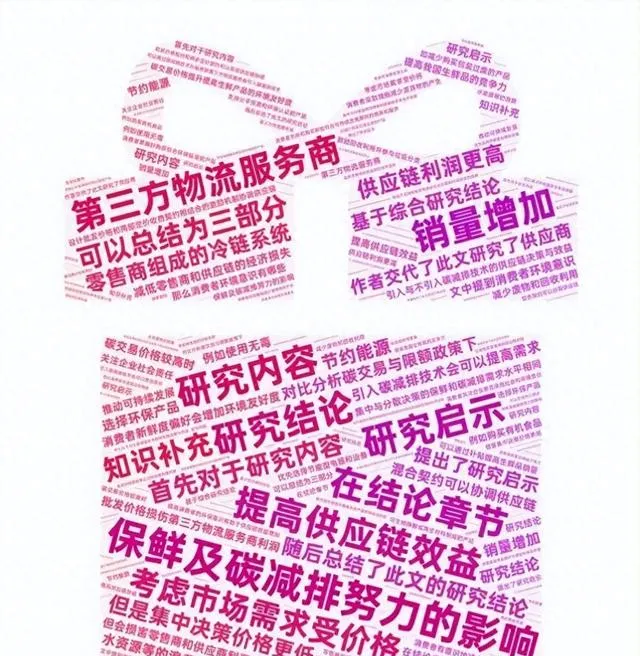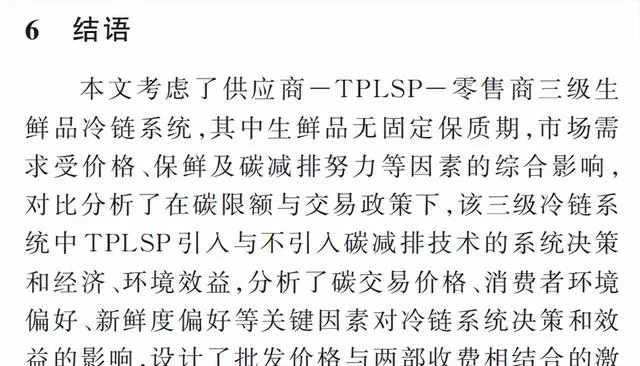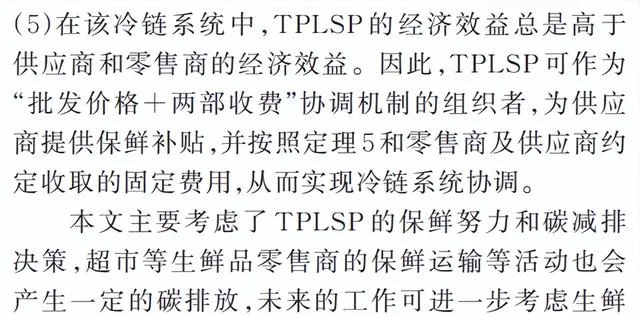
分享興趣,傳播快樂,增長見聞,留下美好。
親愛的您,
這裏是LearingYard學苑!
今天小編為大家帶來
【考慮保鮮努力與碳減排努力的生鮮品三級冷鏈最優決策與協調】結論。
歡迎您的用心存取!
Share interest, spread happiness,
increase knowledge, and leave beautiful.
Dear you,
this is the LearingYard Academy!
Today, the editor brings you
Optimal decision-making and coordination of the three-stage cold chain of fresh products considering preservation efforts and carbon reduction efforts.
Welcome to visit!
本期推文將本透過思維導圖,精讀內容,知識補充三個板塊,展示期刊論文【考慮保鮮努力與碳減排努力的生鮮品三級冷鏈最優決策與協調】結論,請讀者跟著小編一起來學習吧!
This tweet will supplement three ps by mind mapping, intensive reading, and knowledge, and show the conclusion of the journal paper "Optimal decision-making and Coordination of the three-level cold chain of fresh products considering preservation efforts and carbon reduction efforts". Please follow the Xiaoban to learn together!
✦ +
+
思維導圖

✦ +
+
精讀內容
在結論章節,可以總結為三部份,研究內容,研究結論,研究啟示。
首先對於研究內容,作者交代了此文研究了供應商、第三方物流服務商、零售商組成的冷鏈系統。考慮市場需求受價格、保鮮及碳減排努力的影響,對比分析碳交易與限額政策下,引入與不引入碳減排技術的供應鏈決策與效益,設計批發價格和兩部定價收費契約相結合的激勵機制協調供應鏈。
In the conclusion chapter, it can be summarized into three parts: research content, research conclusion and research enlightenment.
First of all, for the research content, the author explains that this paper studies the cold chain system composed of suppliers, third-party logistics service providers and retailers. Considering the impact of market demand on price, preservation and carbon emission reduction efforts, this paper compares and analyzes the supply chain decisions and benefits of introducing and not introducing carbon emission reduction technology under the carbon trading and cap policy, and designs an incentive mechanism combining wholesale price and two-part pricing and charging contract to coordinate the supply chain.

隨後總結了此文的研究結論:1.引入碳減排技術會可以提高需求,提高供應鏈效益。
Then it summarizes the research conclusions of this paper: 1. The introduction of carbon emission reduction technology can increase demand and improve supply chain efficiency.

2.集中與分散決策的保鮮和碳減排需求水平相同,但是集中決策價格更低,銷量增加,供應鏈利潤更高。
2. The demand level of preservation and carbon emission reduction of centralized and decentralized decision-making is the same, but the price of centralized decision-making is lower, sales volume is increased, and supply chain profits are higher.

3.批發價格損傷第三方物流服務商利潤,混合契約可以協調供應鏈。
3. Wholesale price damages the profits of third-party logistics service providers, and hybrid contracts can coordinate the supply chain.

4.碳交易價格提升提高生鮮產品的環境友好度,但會損害零售商和供應商利潤。消費者新鮮度偏好會增加環境友好度。
4. Higher carbon prices improve the environmental friendliness of fresh products, but will hurt the profits of retailers and suppliers. Consumer preference for freshness will increase environmental friendliness.

基於綜合研究結論,提出了研究啟示。1.可以透過碳減排技術補貼鼓勵第三方物流服務商引入碳減排技術,提高中國生鮮品的競爭力。
Based on the comprehensive research conclusions, the research enlightenment is put forward. 1. Carbon emission reduction technology subsidies can be used to encourage third-party logistics service providers to introduce carbon emission reduction technology to improve the competitiveness of fresh products in China.

2.碳交易價格較高時,可以透過補貼提高生鮮品銷量,減低零售商和供應鏈的經濟損失。
2. When the carbon trading price is high, the sales volume of fresh products can be increased through subsidies to reduce the economic losses of retailers and supply chains.

3.提高消費者的環保意識有助於供應鏈效益增加。
3. Improving consumers' environmental awareness contributes to the increase of supply chain efficiency.

4.批發價格契約和兩步定價契約可以實作供應鏈協調。
4. Wholesale price contract and two-step pricing contract can realize supply chain coordination.


✦ +
+
知識補充
文中提到消費者環境意識,那麽消費者環境意識有哪些?
1. 節約能源:消費者有意識地減少電力、水資源等的浪費,優先選擇節能型電器和器材。
2. 減少廢物和回收利用:消費者采取措施減少廢棄物的產生,如減少購買包裝過度的產品,鼓勵回收利用並參與垃圾分類。
3. 選擇環保產品:消費者更偏好購買符合環保標準的產品,例如使用無毒、可生物降解或再生材料制成的產品。
4. 推動可持續發展:消費者支持和購買那些符合可持續發展原則的商品和服務,例如購買有機食品、支持公平貿易和環保認證的產品。
5. 關註企業社會責任:消費者關註企業是否承擔社會和環境責任,傾向於選擇那些具有良好社會形象和環保政策的品牌。
The article mentions consumer environmental awareness, then what is consumer environmental awareness?
1. Energy conservation: Consumers consciously reduce the waste of electricity, water resources, etc., giving priority to energy-saving appliances and equipment.
2. Waste reduction and recycling: Consumers take steps to reduce waste generation, such as reducing purchases of over-packaged products, encouraging recycling and participating in waste sorting.
3. Choose eco-friendly products: Consumers prefer to buy products that meet environmental standards, such as those made from non-toxic, biodegradable or recycled materials.
4. Promote sustainability: Consumers support and purchase goods and services that comply with sustainable principles, such as buying organic food, supporting fair trade and environmentally certified products.
5. Pay attention to corporate social responsibility: consumers are concerned about whether enterprises undertake social and environmental responsibility, and tend to choose brands with good social image and environmental protection policies.
今天的分享就到這裏了。
如果您對今天的文章有獨特的想法,
歡迎給我們留言,
讓我們相約明天。
祝您今天過得開心快樂!
That's it for today's sharing.
If you have a unique idea about today’s article,
welcome to leave us a message,
let us meet tomorrow.
I wish you a nice day !
參考資料:DeepL轉譯,知乎,百度
參考文獻:馬雪麗, 趙穎, 柏慶國等. 考慮保鮮努力與碳減排努力的生鮮品三級冷鏈最優決策與協調 [J]. 中國管理科學, 2023, 31(09): 52-61.
本文由LearningYard學苑整理發出,如有侵權請在後台留言!
文字 | clear
排版| clear
稽核| Young











